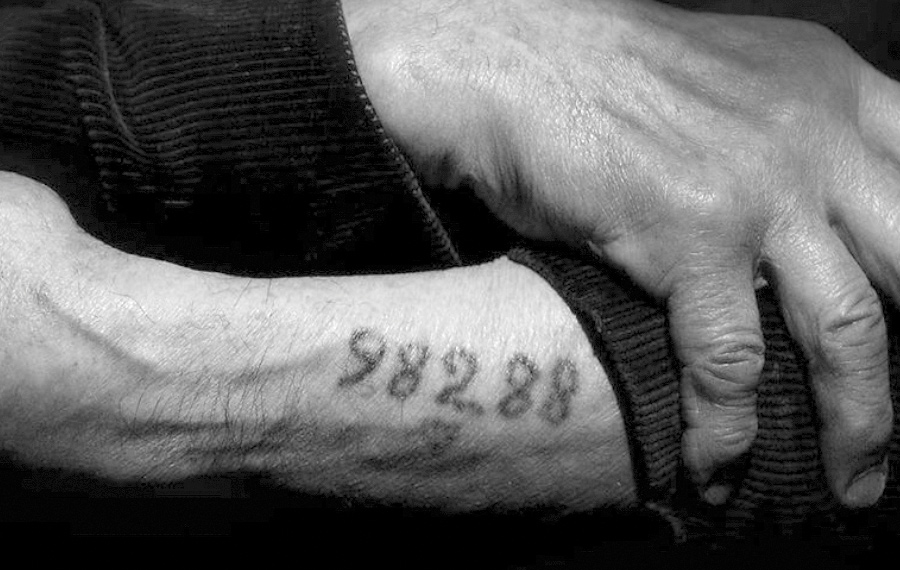
Ashton Gleckman has been obsessed with the Holocaust ever since he attended an Anne Frank exhibit at the Children’s Museum of Indianapolis when he was 6 years old. Watching the films “Schindler’s List” and “Defiance” and discovering that his great-uncle was one of the liberators of Buchenwald, intensified his interest. In 2019, at 18, Gleckman made his debut film about the Holocaust titled, “We Shall Not Die Now.” The documentary is haunting, disturbing and skillfully made, comprehensive in its scope and clear in its message.
“I can’t wait 20 years because survivors of the camps are in their 90s now,” Gleckman told the Journal. “I felt a strong need to get out everything I’ve been thinking about and put it on film.”
In making the documentary, Gleckman used archival photographs and footage — including some from Claude Landsmann’s “Shoah”— obtained from the United States Holocaust Memorial Museum archives. He combined those with 25 interviews he conducted with survivors and their families, perpetrators, liberators and historians. “I wanted to tell the story linearly and take the audience on a journey through the horrors of these events and blend the perspective of the survivors with information about how the Holocaust was engineered,” he said.
Gleckman obtained the interviews at survivor appearances, through Facebook and email. They included Cantor Moshe Taube, rescued by Oskar Schindler; Ben Ferencz, the lead prosecutor at the Nuremberg trials; and Holocaust scholar Michael Berenbaum. “I didn’t get turned down once,” he said. “Survivors want to tell their stories. They’ve made it their obligation to write books and speak at events because they feel that talking about the Holocaust helps us to learn from it and make the world a better place.”
After an intensive research period, Gleckman began interviewing in March and finished with a trip to Poland to film at concentration camps. He described standing alone with his camera in an empty field at Treblinka, at the exact spot where the gas chamber was: “It was a life-changing experience, to say the least.”
To prepare for the project, he took an online filmmaking course with Ken Burns, his role model, and sought donations for production and travel expenses. “I thought about crowdsourcing but decided I wanted to do it by myself. The flights were the biggest expense,” said Gleckman, who lives with his parents and younger sister in Carmel, Ind. “In Poland, I stayed with families I met on Facebook.”
“I can’t wait 20 years because survivors of the camps are in their nineties now. I felt a strong need to get out everything I’ve been thinking about and put it on film”—Ashton Gleckman
His cyber-aided, do-it-yourself approach continued in the editing process. He learned editing via YouTube tutorials and on the Master Class website. “But it was still a lot of trial and error,” he said. He also collaborated on the music for the film with Michael Frankenberger and Benjamin Wallfisch, whose grandmother appears in the film. She played the cello in the orchestra at Auschwitz.
Now 19, Gleckman has been playing music since he was 7 and composing for the past six years, with three albums and a symphony to his credit. As a high school sophomore, he got a job working for Oscar-winning composer Hans Zimmer at his studio and began to score feature and short films. “I never went back to school and I don’t plan on it,” he said.
He has found filmmaking to be complicated and challenging. But he’s enjoying the problem solving, collaboration and travel his inaugural effort required. He plans to shoot his next film, a five-part miniseries about the Battle of Gettysburg, in the spring. He doesn’t rule out making more films about the Holocaust. “There are infinite amounts of stories to tell, maybe as narrative dramas,” he noted. “I have a lot of ideas now.”
Although Gleckman is Russian-Jewish on his father’s side, his mother is not Jewish and he has never practiced Judaism. He does feel a strong connection to Jewish culture and his lineage, however, “especially after making this movie. I’m definitely interested in learning more about [Judaism] now,” he said. “I definitely want to go to Israel.”
Another goal is meeting filmmaker Burns. “I wrote him a handwritten letter and got a call from his producer. I haven’t spoken to him directly yet,” he said. “I hope I get to.”
Right now, Gleckman wants to make sure as many people see his film as possible. “We’re going to make it available for free on YouTube’s Timeline World History channel as well as Amazon and streaming platforms,” he said. “And we have a trimmed-down, 50-minute educational version and study guide that we’re making available to schools”.
Gleckman pointed out the documentary’s relevance in light of the rise in hate in the world. “The Holocaust was not an isolated event, and it’s still going on in different forms, like it did in Rwanda and Cambodia and now Syria,” he said. “We don’t seem to learn from the past, and this film is dedicated to trying to remember the past in order to inform the present.”
He hopes viewers come away with “a sense of hope and a sense of vigilance. We have to stand up. The Holocaust happened because people let it happen. Enough
is enough.”
“We Shall Not Die Now” is available on Amazon Prime video.






















 More news and opinions than at a Shabbat dinner, right in your inbox.
More news and opinions than at a Shabbat dinner, right in your inbox.